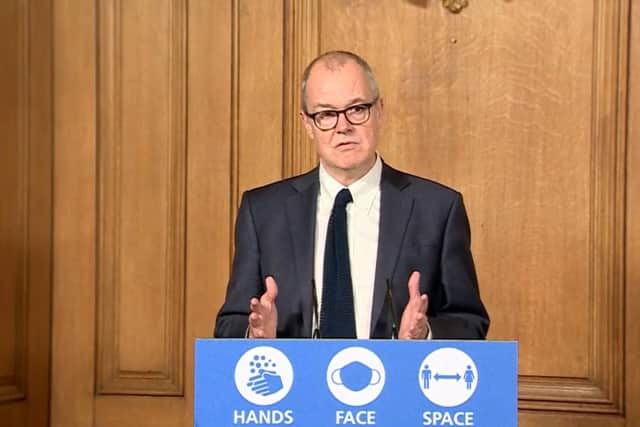Downing Street defends statistics used to justify second lockdown after criticism from MPs
Top-end projections suggesting that daily hospital admissions in England could reach nearly 9,000 by early December, while daily deaths could hit 1,400, have both now been revised downwards.
The disclosure came after Tory MPs, led by former prime minister Theresa May, strongly criticised the way the Government used data to justify a second national lockdown in England.
Advertisement
Hide AdAdvertisement
Hide AdYorkshire MP Imran Ahmad Khan yesterday said the use of incorrect data was “unpardonable”.


The Conservative MP for Wakefield said: “It is clear that some of the evidence presented to the Prime Minister and broadcast to the nation, was not fit for purpose. The Prime Minister, like all citizens of the United Kingdom, requires and deserves reliable, unspun, information.
“The modelling used as reference at the weekend, which illustrated a scenario of 4000 deaths per day using a fatality rate of 0.7 per cent, was unpardonable.
“As former Supreme Court Justice, Lord Sumption, remarked to a group of colleagues and myself, these were figures designed to frighten, not inform. Nowhere on Earth, not even in India at a time of peak crisis, with a population 20 times ours, have we seen such a figure.
Advertisement
Hide AdAdvertisement
Hide Ad“My parliamentary colleagues have been organising numerous sessions to understand and interpret the data and interrogate the analysis.”
He said he had also attended a session with Sir Jeremy Farrah, a member of SAGE and director of the Wellcome Trust, who he said “explained the updated data with clarity, honesty and most importantly, without spin – qualities we require from all members of SAGE”.
And while he backed the second lockdown measures, after hearing from the Chief Executive of Pinderfields Hospital on his concerns, he added: “A better and clearer process needs to be established to allow trusted parliamentary colleagues access to all the data so they can interrogate and challenge it before policy is set.
“At a time of such immense strain, we need to ensure that correct decisions made by the Government are comprehensively evidenced and expressed with clarity to the public to rebuild and retain their trust.”
Advertisement
Hide AdAdvertisement
Hide AdMinisters have maintained that it was the right decision, saying the NHS faced being overwhelmed if action was not taken to curb the spread of the disease.
And the Prime Minister’s official spokesman said today that Boris Johnson had addressed the issue but that No 10 had “made clear that we obviously want to try and make the data as transparent and clear as we can, and that's what we tried to do throughout the press conferences, and we'll continue to do this”.
He said on the specific errors: “There was no error in the underlying analysis.”
During the Downing Street press conference on Saturday evening, chief scientific adviser Sir Patrick Vallance presented two slides showing projections for daily hospital admissions and daily deaths in England.
Advertisement
Hide AdAdvertisement
Hide AdBoth projections were by the Scientific Pandemic Influenza Group on Modelling, or SPI-M, an independent body that provides expert advice to the Government on matters relating to the UK’s response to threats from human infectious diseases.
The slide for hospital admissions in England presented by Sir Patrick showed a medium-term projection that had a top-end range of nearly 9,000 admissions a day by December 8.
But on Tuesday this slide was reissued with the top-end range revised down to just over 6,000 a day.
The Government said the amendment had taken place “after an error was found” in the ranges for the projections.
Advertisement
Hide AdAdvertisement
Hide Ad“This does not affect the insights that can be taken from these analysis,” it added.
The central projection for daily hospital admissions was unchanged on the amended slide, which showed the number reaching just over 4,000 a day by December 8.
The second slide presented by Sir Patrick on Saturday was for daily deaths in England.
This showed a projection that had a top-end range of more than 1,400 deaths a day by December 8 – well above the first-wave peak of almost 1,000.
Advertisement
Hide AdAdvertisement
Hide AdBut this slide was also reissued on Tuesday, now with the top-end range revised down to around 1,000 deaths a day by December 8.
Again, the central projection was unchanged on the amended slide, which showed daily deaths in England reaching just under 800 by December 8.
The Government said this amendment was also due “an error” in the ranges for the projections.
The disclosure came after the official statistics watchdog publicly warned Sir Patrick over the Government’s use of data during the Covid-19 pandemic.
Advertisement
Hide AdAdvertisement
Hide AdIn a letter to the chief scientist, the Office for Statistics Regulation warned that the lack of transparency surrounding some of the figures meant there was “potential to confuse the public and undermine confidence in the statistics”.
Professor Carl Heneghan, of Oxford University, went further, tweeting: “The Government’s use of data is not just confusing – the errors are positively misleading.”
Business Minister Nadhim Zahawi said it was an “irrefutable” fact that hospital admissions are rising sharply and insisted the Government has to get the R number – representing the reproduction rate of the disease – down.
“I take on board what the official statistics watchdog said. We will always try to improve our graphs and our presentations,” he told Sky News.
Advertisement
Hide AdAdvertisement
Hide Ad“But, at the same time, the facts are very clear that we had to make this very difficult decision.
“I am certain that actually this decision is the right one but will also ultimately deliver what we all want to see, which is that reduction in the R number.”
Comment Guidelines
National World encourages reader discussion on our stories. User feedback, insights and back-and-forth exchanges add a rich layer of context to reporting. Please review our Community Guidelines before commenting.